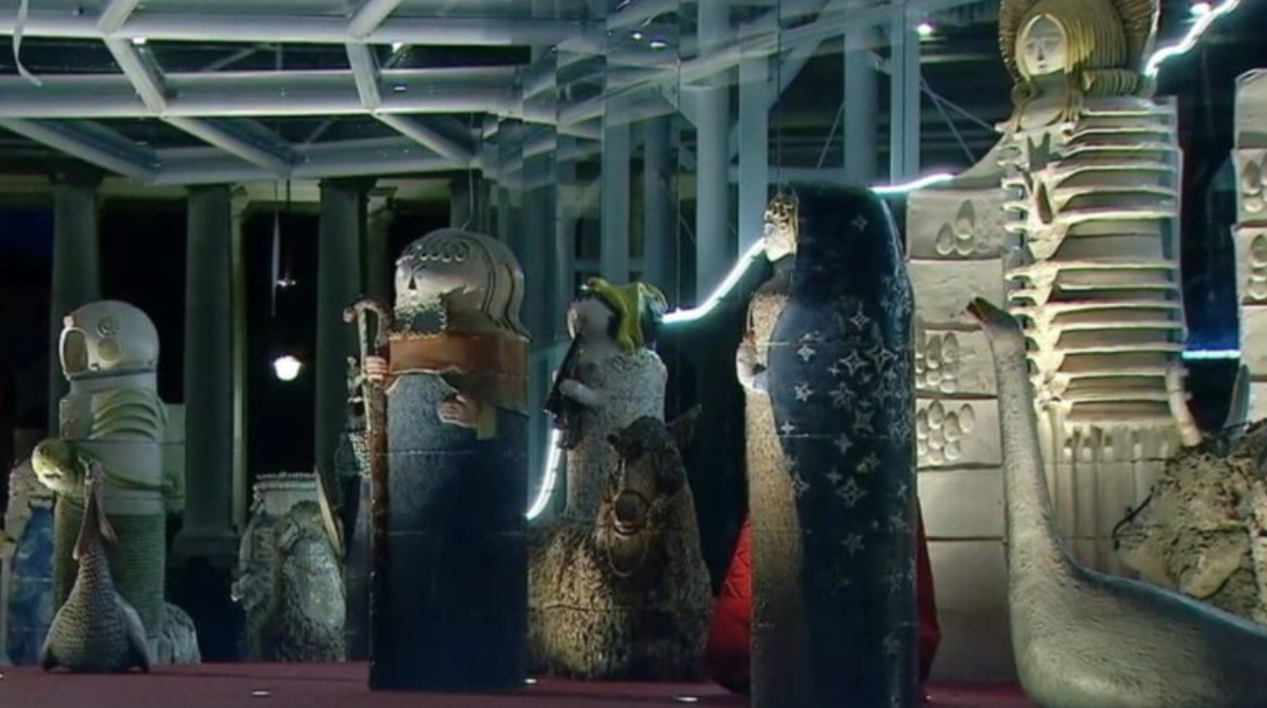Presepi. Nativity Scenes in Italy
The tradition of putting nativity sculptures in church dates back to the Middle Ages, even though before this period there were images and representations of the birth of Jesus. It was Saint Francis of Assisi, though, who popularized the image of the crib and thereby started the tradition of the presepe. In a cave in the village of Greccio in the Rieti Valley in central Italy on Christmas Eve of 1223, Saint Francis wished to recreate the scene of the birth of Jesus in Bethlehem. He prepared a straw-filled manger set between a live donkey and an ox in a cave, added a statue of the Holy Child, and held Christmas Eve mass. Since then, the representation of the nativity has spread all over Italy in many ways.
The stylistic shapes and the use of materials are deeply influenced by geographical place and popular traditions. In the 15th century the idea of placing large statues of saints in churches began the tradition of situating nativities in sacred places. One of the oldest is the monumental presepe in the Basilica of Santo Stefano in Bologna which is prepared each year during the Christmas season. In the 17th century nativity scenes started to appear in the houses of noble families and were displayed as knick-knacks or as miniature chapels.
The materials used to create a presepe varied according to the location: marble, terracotta, and wood were used, as well as coral, ivory, bone, mother-of-pearl, alabaster, and shells. In the 18th century in Naples, the Bourbon king Charles III had a real passion for this art form and under his reign the city became the capital of the presepe. This passion for presepe influenced the entire population, beginning with the king who, having a deep interest in sophisticated mechanical models, with the help of architects and artists added mechanized figurines to the presepe. His wife, the queen Maria Amalia, spent months sewing rich dresses for the statues, assisted by court tailors. It started a sort of competition between families over who had the most valuable presepe: the nobles devoted rooms of their mansions to display magnificent nativity scenes with statues covered in precious clothes and real sparkling jewels.
Among the many statues crowding such rich presepi, it was possible to recognize characters of the local nobility as well as the middle and lower classes, all engaged in their typical daily activities: drinking in taverns, fishing, selling products by the road, dancing, serenading a woman, etc. These nativities went beyond the original sacred intent. In fact moments inspired by contemporary life with precise geographical elements were included, such as Mount Vesuvio or the Campania landscape in the background.
In the same century in Bologna, the Santa Lucia Fair was established, an annual market of nativity statues created by craftsmen. This fair still continues today after more than two centuries.
The Roman Baroque tradition is another important period in the history of presepi. In Rome the most important families created magnificent presepi to be displayed with pride during sumptuous Christmas dinners. The Roman presepe, like the Neapolitan, reproduced the typical local country landscape with pine and olive trees and the ancient aqueducts in the background. With time, presepi appeared in common people’s homes and became a deeply respected tradition in Italy.
It is possible to see the best presepi in Naples, where hundreds of nativity scenes are erected throughout the city. Some of them are very elaborate and are mostly handmade. Some statues are true antiques and can even cost thousands of euros.
The street of San Gregorio Armeno in central Naples is filled with shops displaying stands full of nativity scenes. The peculiarity is that near the traditional statues of angels, shepherds, Saint Joseph, and the baby Jesus, it is possible to see contemporary figures.
In the Vatican there is a huge presepe in St. Peter’s Square for Christmas. In Rome some of the biggest and most elaborate presepi can be found in the churches in Piazza del Popolo, Piazza Euclide, Santa Maria in Trastevere, and Santa Maria d’Aracoel on the Capitoline Hill. The Church of Saints Cosimo and Damiano, by the main entrance to the Roman Forum, has an antique and large nativity scene from Naples on display all year.
Another important tradition in Italy is the living nativity scene called presepi viventi. We will tell you about them even if this year there will be no due to the restrictions for Covid 19. Costumed people act out the events of the nativity, sometimes over several days, usually on Christmas Day, December 26, as well as on January 6, the day of the Epiphany which is also the 12th day of Christmas, when three Wise Men, the Magi, brought their gifts to Jesus.
There are many living nativities all over Italy. The one held in Chia in northern Lazio has more than 500 participants. In Custonaci, a small town near Trapani in Sicily, the nativity scene is re-enacted inside a cave. During the festivities the entire town is set up to resemble an ancient village with craftspeople and small shops. In Rivisondoli in the Abruzzo region, there is a living nativity on December 24 and 25 and the re-enactment of the arrival of the three kings on January 5 with hundreds of costumed participants.
This year the 'Vatican' nativity scene which has sparked several controversies. Not the traditional hut, with the symbolic 'Holy Living Family', but the ancient art of Castelli's Abruzzo ceramic. This year Mary, Joseph, ox, donkey, little shepherds and the Magi take on the appearance of pagan idols.
The New York Times also reported on this crib, concluding "It's a crib that has had problems, as we all have had in this bad year. If it did, we can do it too"





































i-Italy
Facebook
Google+
This work may not be reproduced, in whole or in part, without prior written permission.
Questo lavoro non può essere riprodotto, in tutto o in parte, senza permesso scritto.